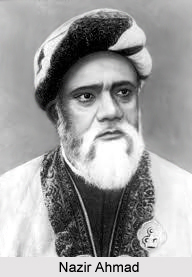 Urdu novelists in 19th century played a major role in the dissemination and spread of this prose form. Initially, the novel form was not acknowledged as an acceptable writing form and its content was considered inappropriate for women and young children. Understandably, then, Nazir Ahmad (1833-1912), now regarded as the pioneer of the Urdu novel, never thought of himself as a novelist and deliberately avoided calling his works novels. For him, novels were as objectionable as traditional romantic tales, verse epics, and love poetry.
Urdu novelists in 19th century played a major role in the dissemination and spread of this prose form. Initially, the novel form was not acknowledged as an acceptable writing form and its content was considered inappropriate for women and young children. Understandably, then, Nazir Ahmad (1833-1912), now regarded as the pioneer of the Urdu novel, never thought of himself as a novelist and deliberately avoided calling his works novels. For him, novels were as objectionable as traditional romantic tales, verse epics, and love poetry.
Muhibb-i Husain, while presenting novels, felt the need to stress the different character of these works, as compared with what usually went under the label `novel`. One of the later reformers who made conscious use of the popular novel format to propagate his ideas was Lala Daulat Ray Varma. In the introduction to his social novel "Roti Kyon ho" (1891) he wrote that while there was a growing interest in the novel, few were written in simple language, `Poetic temperament and amorous ideas have left a deplorable impact on the country, but very few people have thought of depicting the domestic situation. ` His novel describes the nasty consequences arising from existing Hindu marriage customs. Kanta, another book by the same author, is as a romance, exposing the evils of Hindu marriage customs. This characterisation points to the fact that many of the later reformers used romance and melodrama to convey their messages, a practice that Nazir Ahmad had largely avoided.
One of the greatest writers in this genre is Abdul Halim Sharar. He was a prolific writer of historic novels, being greatly inspired by Walter icon`s novels. The main objective of Sharar`s historical romances was to demonstrate the glory of Islam in the past and the ethical superiority of Muslims over Christians during the Crusades. Along with this the lack of unity among the Muslims was a major theme. The later half of the 19th century was one of the most productive periods of novel writing in Urdu.
By the end of the nineteenth century, English education had spread among Urdu speakers and access to English fiction or translations from English into Urdu had become easier. Some novelists were employed in the British administration, e.g. Lala Daulat Ray as Revenue Accountant, and Munshi Ahmad Husain Khan as Official Translator. The impact of the overall cultural atmosphere can be seen in attempts to present images of modern life in otherwise conservative texts, and in the attempt to achieve originality. Thus there can now be found titles of books like Angrezi Insaf ka Sachcha Naval (A True Novel of English Justice) by Gopinath, Lahore, 1895-6; the Fasana-i Nadir Jahan by Hosh (1918) bears the subtitle `Dilchasp aur Sachcha Afsana (Interesting and True Story). Another book, Virmati by Munshi Sharan Shankar `Sha`iq` (Agra, 1909), bears the subtitle `Iffat-o-`ismat ka Foto (A Photo of Chastity and Virtue), indicating an authentic picture. Realism now figured prominently in the works of the new critics. Thus novelists started to claim that their works were pictures of `real life` and of `nature`, no matter how far removed from the realistic form their texts actually be were.
The encounter with English education and culture became one of the central themes of Urdu novels in the late nineteenth century. This was taken up by numerous authors in diverse ways, including within reformist and ideological works such as Nazir Ahmad`s Ibnu`l-Vaqt (The Son of the Time, 1888) as well as a number of commercial novels. These authors usually ridiculed the blind and superficial imitation of English manners and lifestyle, this ridicule being influenced perhaps by Bengali literature, which had deployed this theme much earlier. Novels also started to focus on the pros and cons of modern education for girls. Education for girls and women was among the main themes of Urdu reformist writing in the second half of the nineteenth century. Apart from well-known authors like Nazir Ahmad, Sarshar and Sharar, less-known reformers as well as commercial writers took up this subject.



















